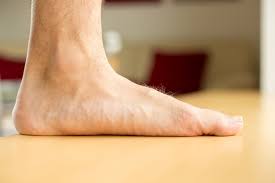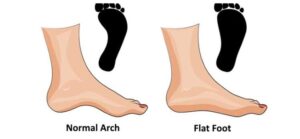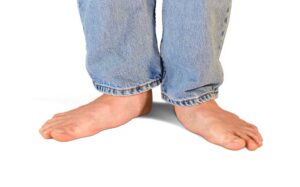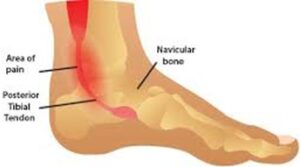

Forward head posture (FHP) is often blamed for neck stiffness, tension headaches, and shoulder pain—but what if we told you it could also be the reason behind your fallen arches?
Yes, that posture problem up top may be silently sabotaging the very foundation of your body: your feet.
As bizarre as it sounds, poor alignment of the head and neck can trigger compensatory patterns that cascade through your spine, pelvis, knees, and ultimately end at the soles of your feet.
This article by BestForwardHeadPostureFix explains how a misaligned head posture can, over time, lead to flat feet.
Article Index
- Understanding Forward Head Posture
- The Kinetic Chain: Connecting Head to Feet
- How Forward Head Posture Affects the Spine and Pelvis
- Impact on Lower Limb Alignment
- Development of Flat Feet Due to Postural Changes
- Research Supporting the Connection
- FAQs on Neck Posture & Flat Feet
- Preventive Measures and Corrections
My Opinion on Forward Head Posture
Forward head posture (FHP) has become almost a modern epidemic—especially if you spend your days glued to screens like most of us do.
It happens when your head subtly but persistently leans forward past your shoulders, disrupting the natural alignment where your ears should ideally sit directly above the collarbone line.
This forward drift might seem harmless, but it shifts your center of gravity and creates a surprising amount of biomechanical stress.
For every inch your head moves forward, your cervical spine absorbs an extra 10 pounds of pressure.
That is like hanging a bowling ball off your neck all day. This chronic load triggers muscular fatigue, disc compression, and nerve irritation.
Over time, it can evolve into more serious issues such as tension headaches, cervical radiculopathy, and even early degenerative joint changes.
The causes of FHP range from poor desk ergonomics and phone scrolling to stress-related muscular tension.
What is less known is its impact beyond the neck: FHP can restrict airway space, reduce lung capacity, and impair balance and proprioception.
Some studies even suggest it may influence mood and cognitive performance due to altered neural input.
Correcting FHP is not just about standing straight—it requires a combo of ergonomic fixes, postural awareness, and neck-shoulder strengthening exercises. Your spine—and sanity—will thank you.
The Kinetic Chain: Connecting Head to Feet
The body is not just a pile of parts—it is an intricately connected kinetic chain, where one misalignment can spark a ripple of compensations from head to toe.
Forward head posture might seem like a minor deviation, but it kicks off a full-body domino effect.
When the head juts forward, the thoracic spine tends to round in response, which flattens the natural lumbar curve and causes the pelvis to tilt anteriorly.
These adjustments may feel automatic, but they carry biomechanical consequences.
Muscles that were once balanced are now under constant tension or slackened.
The hip flexors tighten, the glutes weaken, and the hamstrings overwork to stabilize your posture.
Down at the feet, this cascade throws off the alignment of the ankles and shifts weight unevenly across the arches.
Over time, this can lead to overpronation, plantar fasciitis, or flat feet.
So yes—your neck position can change how your feet bear your weight. The chain never lies.
How Forward Head Posture Affects the Spine and Pelvis?
When the head shifts forward—even by just an inch—your spine kicks into defense mode.
To prevent collapse under the pull of gravity, the upper back muscles, particularly the trapezius, levator scapulae, and rhomboids, become overactive and tight.
This chronic tension can cause discomfort between the shoulder blades and reduce shoulder mobility over time. Simultaneously, the lower back often loses its healthy lordotic (inward) curve as the pelvis tips forward into an anterior pelvic tilt.
This pelvic tilt isn’t just a minor adjustment—it has a domino effect on the lower body. The hip flexors, especially the iliopsoas and rectus femoris, become shortened and overused.
In contrast, the gluteal muscles and core stabilizers weaken, compromising pelvic stability. This imbalance alters how the body absorbs and transmits forces during walking or standing.
With the pelvis misaligned, weight shifts disproportionately through the knees, ankles, and feet. The altered mechanics change gait patterns and foot strike.
Instead of an even heel-to-toe roll, individuals may begin to collapse inward at the arch—leading to overpronation, reduced shock absorption, and eventual flattening of the medial arch.
Essentially, what begins in the neck ends at the foot, reshaping posture, performance, and long-term joint health.
Impact on Lower Limb Alignment
Once the pelvis tips forward into an anterior tilt, the disruption does not stop there—it trickles down the kinetic chain and lands squarely at your knees and ankles. This shift causes the femurs (thigh bones) to internally rotate, which places abnormal stress on the knee and hip joints and alters their natural alignment.
As the knees fall inward (a condition called genu valgum or “knock-knees”), the feet are forced to compensate, often resulting in overpronation.
Overpronation is when the foot rolls too far inward with each step. Although mild pronation helps absorb shock, excessive pronation flattens the medial longitudinal arch.
This ongoing collapse places strain on the plantar fascia, tibialis posterior tendon, and intrinsic foot muscles—structures vital for maintaining a healthy arch.
Over time, this can lead to flat feet, plantar fasciitis, shin splints, and even Achilles tendonitis.
But it does not end with the feet. This altered foot posture reduces sensory input (proprioception) from the ground to the brain, which is essential for maintaining upright balance and spinal alignment.
This faulty feedback loop contributes to poor postural awareness, encouraging the head to jut even further forward—completing a vicious cycle of dysfunction that all began with a slight pelvic shift.
Development of Flat Feet Due to Postural Changes
Flat feet (pes planus) develop when the medial arch of the foot collapses, causing the entire sole to nearly contact the ground.
While some people are born with this condition, many develop it gradually due to postural imbalances—especially those starting from the head and spine.
Here is how forward head posture contributes to functional flat feet:
- Altered spinal mechanics: Forward head posture causes compensatory changes in the spine and pelvis, often resulting in anterior pelvic tilt.
- Internal leg rotation: The pelvis shift promotes internal rotation of the femurs (thigh bones), which in turn rotates the tibias and affects lower limb alignment.
- Overpronation of the foot: This internal rotation causes the feet to roll excessively inward while walking or standing—a condition called overpronation.
- Arch collapse: Repeated overpronation stretches the plantar fascia and weakens intrinsic foot muscles like the tibialis posterior, eventually flattening and causing pain in the arch.
- Muscle imbalance: Some muscles, like the calf (gastrocnemius) and arch stabilizers, become overused, while others remain underutilized, further degrading support.
- Loss of shock absorption: As the arch flattens, the foot loses its springy, shock-absorbing function, becoming rigid and prone to strain.
- Progressive condition: These changes accumulate slowly over months or years, making flat feet a long-term consequence of unresolved upper-body postural dysfunction.
Research Supporting the Connection
The connection between postural alignment and foot structure is not just theoretical—it is backed by a growing body of scientific research.
Multiple studies have confirmed that changes in upper body posture, particularly in the cervical spine, can trigger compensatory adaptations throughout the musculoskeletal chain, eventually affecting foot mechanics.
A study in the Journal of Back and Musculoskeletal Rehabilitation revealed that forward head posture and cervical misalignment were linked to lower limb compensation, including altered ankle position and foot posture.
These compensations were not subtle—they directly influenced gait patterns and weight distribution.
Similarly, research published in the International Journal of Environmental Research and Public Health found a clear correlation between forward head posture and static foot structure.
Individuals with pronounced head tilt exhibited collapsed medial arches and abnormal plantar pressure distribution, suggesting that faulty upper body posture compromises the foot’s natural support system.
Further supporting evidence comes from the Journal of the American Podiatric Medical Association, where researchers observed that anterior pelvic tilt and spinal misalignment affected how weight was transmitted through the lower limbs.
This shift in loading patterns gradually altered arch integrity, increasing the risk of flat feet.
Together, these findings reinforce a critical point: misalignments in your neck and spine do not stay local—they cascade downward, right into your soles.
Preventive Measures and Corrections
If your head is creeping forward and your arches are fading fast, it is not too late to intervene. Addressing both neck posture and foot alignment simultaneously is key.
Here are science-backed strategies to prevent or correct posture-induced flat feet:
- Ergonomic corrections: Adjust your workstation so screens are at eye level and you’re not jutting your head forward.
- Postural training: Focus on exercises that strengthen deep cervical flexors and thoracic extensors. Chin tucks, wall angels, and thoracic mobility drills can help.
- Pelvic alignment work: Engage the glutes, stretch the hip flexors, and retrain pelvic stability with exercises like bridges and clamshells.
- Foot strengthening: Practice short foot exercises, towel curls, and barefoot balancing on uneven surfaces to activate intrinsic foot muscles.
- Supportive footwear or orthotics: Temporary use of orthotics may provide arch support while you retrain proper postural mechanics.
- Regular movement: Avoid static postures. Set reminders to move or stretch every 30–45 minutes if you sit for long periods.
Addressing only one end of the kinetic chain (like the foot) without correcting the root cause (the neck) is like bailing water from a leaky boat without plugging the hole.
FAQs on Forward Neck and Flat Feet
Q-1: By what mechanism could a forward head posture (FHP) nudge feet toward a flatter, more pronated stance?
A-1: When the head shifts forward, your body counterbalances by moving the center of mass anteriorly. That small shift increases front-of-foot loading and postural sway. The foot often responds by widening the base—more time in pronation and midfoot contact—to keep you stable. Over months of screen-heavy routines, this compensation can mimic or aggravate a “flat-foot” presentation, especially during standing tasks.
Q-2: Can changing my head and neck position alter what my feet are doing right away?
A-2: Often, yes. If you gently “stack” (soft chin nod, crown tall, sternum lifted without flaring ribs), many people feel pressure ease off the forefoot and spread more evenly toward the rearfoot. That immediate shift reflects shared balance control: when the upper spine aligns, your nervous system reduces the need for the feet to over-pronate as emergency shock absorbers.
Q-3: If my arches already trend low, does FHP make upstream mechanics worse—or does foot posture drive the neck?
A-3: It is a loop. Flexible flatfoot can change knee and hip loading higher up; meanwhile, forward head posture increases sway that the feet must manage below. The result can be “two ends feeding the middle”: more pronation to catch the forward drift, and altered hip/pelvis mechanics that keep the drift going. Addressing only the foot or only the neck leaves part of the loop intact.
Q-4: How can I test at home whether my head position is influencing my feet?
A-4: Try a 60-second A/B check:
Stand barefoot on a hard floor, look straight ahead, and notice where you feel pressure (heel vs. midfoot vs. forefoot).
Keep your gaze level, make a tiny chin nod, imagine length through the crown, and gently lift the sternum.
Many notice an immediate shift toward more heel contact and less midfoot “splat.” For a simple visual, step onto a damp bathmat before and after—flatter midfoot outlines often shrink with the stacked posture.
Q-5: What practical steps address both FHP and foot collapse in daily life?
A-5: Pair upstream and downstream fixes:
Upstream: raise screens to eye height, use a 45–60-minute “posture ping,” add 5–8 reps of thoracic extensions and 2–3 sets of gentle deep-neck-flexor nods.
Downstream: strengthen foot intrinsics (short-foot, toe yoga), build calf/soleus endurance (slow raises), and use supportive shoes or temporary orthoses during long standing.
Integration: practice a 10-step walk holding the stacked posture, then transition to normal gait. Track progress with a weekly side photo (ear over shoulder) and a quick standing pressure check.
This two-end approach reduces the forward drift that provokes pronation while giving the arches the strength and time they need to rebound.
Takeaway: Look Up to Protect Your Arches
Forward head posture may begin in the neck, but its effects cascade downward like a slow-motion landslide.
As the head juts forward, the spine compensates, the pelvis tips, the femurs rotate inward, and the knees and ankles lose alignment—ultimately causing the arches of your feet to collapse.
What starts as a subtle neck misalignment can spiral into chronic flat feet over time.
Flat feet, then, are not just a local foot problem—they are often the final link in a long chain of postural dysfunction.
Slapping on arch supports or foot orthotics may relieve symptoms temporarily, but they would not fix the underlying cause if your upper body remains misaligned.
True correction starts at the top. By restoring proper cervical posture, improving thoracic mobility, and stabilizing pelvic position, you can reduce the compensations that lead to collapsed arches.
Think of your body as one continuous structure: when the head realigns, the rest can follow.
Stand tall, move mindfully, and give your feet a fighting chance to reclaim their natural support and function.
References:


